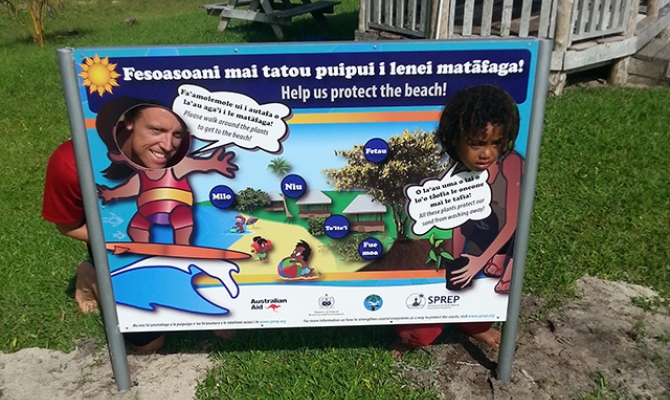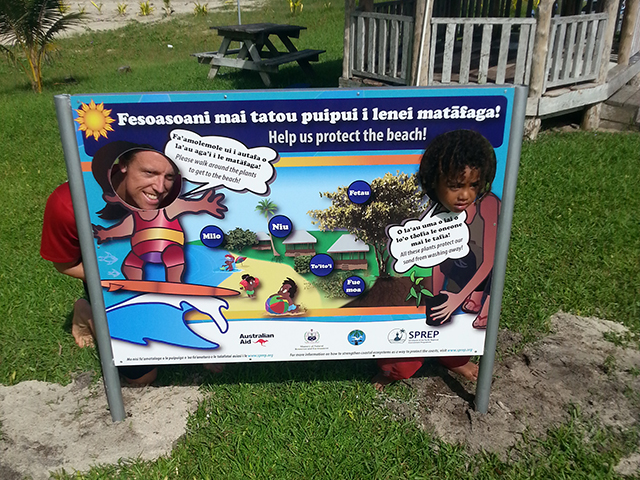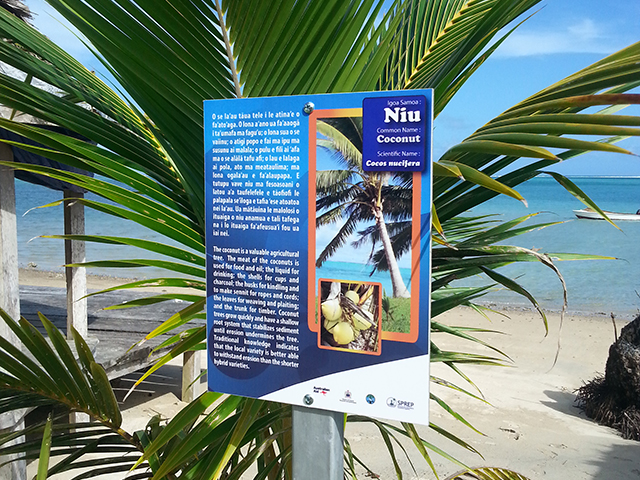
Biodiversity Conservation
At the core of the idea of Natural Solutions for Island Resilience is empowering communities to take action for a healthy environment.
Healthy ecosystems can help Pacific islands better adapt to climate change as they are better able to 'bounce back' from the impacts of severe weather patterns and natural disasters.
In Kiribati, the Secretariat of the Pacific Regional Environment Programme (SPREP) has fully implemented coastal Ecosystem based Adaptation (EbA) activities by planting coastal vegetation and carrying out monitoring at selected sites, putting in place other suitable coastal erosion control methods using natural materials, carrying out site visits to the outer islands and raising awareness about the value of coastal EbA, identifying needs for coastal EbA.
The Secretariat of the Pacific Regional Environment Programme (SPREP) is also working with partners in Samoa to help communities take action. One activity in particular is bringing fun into learning about nature conservation through a project to protect Vaiula Beach from further erosion at Tafatafa.
If you happen to spend a weekend here, you will come across a newly installed billboard with a twist. In addition to messages about protecting the beach, this billboard provides a fun photo opportunity that allows you to be part of the call for good environment practices. A cut out in the board allows you to take an action photo and share the strong messages.
Since its installation, the billboard has already proven popular with locals.

"Incorporating fun into the spirit of learning about how we can protect our environment is always a winner," said Mr. Vainuupo Jungblut, the Oceania Ramsar Officer at SPREP.
"We want to share knowledge about the need to prevent beach erosion and help more people get involved in protecting the environment. While it is fun, there is a very important overall message behind this – we need to work together with nature if we are to build island resilience."
This billboard is just one of many different new signage designed to engage communities and visitors alike in looking after the island's natural environment.
The beach strengthening project has seen the planting of coastal tree species that are native plants to Samoa. Each tree species also has a sign next to it explaining how the plant benefits the beach and the local Samoan community.
Not only will these trees enhance the natural feel of the site, provide shade, fruits and seeds that can be eaten and used for their healing properties, they will also help secure and strengthen the coastline once they mature.
Natural solutions for Island Resilience at work.
"We hope that the more that communities learn about the role of these plants and how they can help benefit them, then the more that the communities take ownership of caring for the plants and the role of good environmental practices in helping to protect their surroundings."

The tree species planted are: To'ito'i also known as the beach naupaka, Scaevola taccada; Niu or Coconut, Cocos nucifera; Milo, also known as the Portia tree, Thespesia populnea; Fue moa, Beach morning glory, Ipomoea pes-caprae and the Fetau, Alexandrian Laural, Calophyllum inophyllum.
The trees and their roots will help hold the sand in place in times of high seas and waves.
This project is a culmination of a partnership between (please list these) the Ministry of Natural Resources and Environment, Government of Samoa, SPREP and the Vaiula Beach Fales. This project has been made possible through funding assistance the Government of Australia under its International Climate Change Adaptation Initiative (ICCAI).
Healthy ecosystems can help Pacific islands better adapt to climate change as they are better able to 'bounce back' from the impacts of severe weather patterns and natural disasters.
In Kiribati, the Secretariat of the Pacific Regional Environment Programme (SPREP) has fully implemented coastal Ecosystem based Adaptation (EbA) activities by planting coastal vegetation and carrying out monitoring at selected sites, putting in place other suitable coastal erosion control methods using natural materials, carrying out site visits to the outer islands and raising awareness about the value of coastal EbA, identifying needs for coastal EbA.
The Secretariat of the Pacific Regional Environment Programme (SPREP) is also working with partners in Samoa to help communities take action. One activity in particular is bringing fun into learning about nature conservation through a project to protect Vaiula Beach from further erosion at Tafatafa.
If you happen to spend a weekend here, you will come across a newly installed billboard with a twist. In addition to messages about protecting the beach, this billboard provides a fun photo opportunity that allows you to be part of the call for good environment practices. A cut out in the board allows you to take an action photo and share the strong messages.
Since its installation, the billboard has already proven popular with locals.

"Incorporating fun into the spirit of learning about how we can protect our environment is always a winner," said Mr. Vainuupo Jungblut, the Oceania Ramsar Officer at SPREP.
"We want to share knowledge about the need to prevent beach erosion and help more people get involved in protecting the environment. While it is fun, there is a very important overall message behind this – we need to work together with nature if we are to build island resilience."
This billboard is just one of many different new signage designed to engage communities and visitors alike in looking after the island's natural environment.
The beach strengthening project has seen the planting of coastal tree species that are native plants to Samoa. Each tree species also has a sign next to it explaining how the plant benefits the beach and the local Samoan community.
Not only will these trees enhance the natural feel of the site, provide shade, fruits and seeds that can be eaten and used for their healing properties, they will also help secure and strengthen the coastline once they mature.
Natural solutions for Island Resilience at work.
"We hope that the more that communities learn about the role of these plants and how they can help benefit them, then the more that the communities take ownership of caring for the plants and the role of good environmental practices in helping to protect their surroundings."

The tree species planted are: To'ito'i also known as the beach naupaka, Scaevola taccada; Niu or Coconut, Cocos nucifera; Milo, also known as the Portia tree, Thespesia populnea; Fue moa, Beach morning glory, Ipomoea pes-caprae and the Fetau, Alexandrian Laural, Calophyllum inophyllum.
The trees and their roots will help hold the sand in place in times of high seas and waves.
This project is a culmination of a partnership between (please list these) the Ministry of Natural Resources and Environment, Government of Samoa, SPREP and the Vaiula Beach Fales. This project has been made possible through funding assistance the Government of Australia under its International Climate Change Adaptation Initiative (ICCAI).